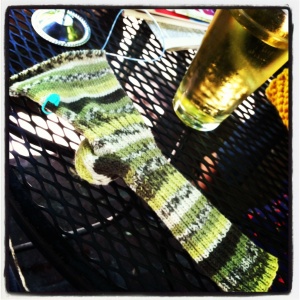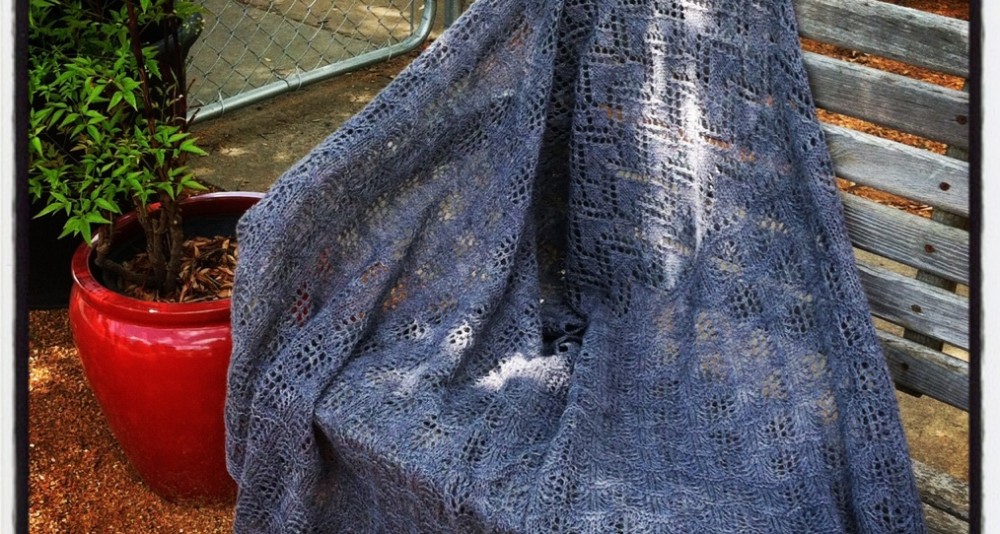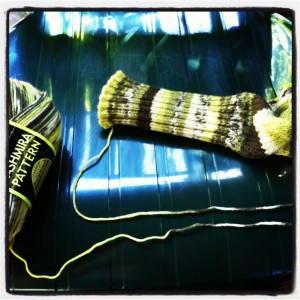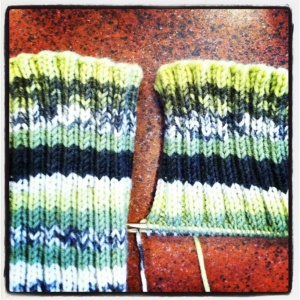I really like sock yarn, for a number of reasons.
One, it’s generally pretty affordable. A couple skeins of sock yarn isn’t going to break you.
Two, it’s an excellent choice for “souvenir yarn”, that yarn you buy because you’re visiting somewhere and you must visit the LYS (Local Yarn Store), or you won’t have any idea what the place you’re visiting is really like. You wouldn’t want to buy a “large project” amount of yarn, since you can’t easily go back to buy more (if you run out), or to return the extra skeins you buy (so you don’t run out). So, a couple of skeins of sock yarn are good for something you can knit up pretty quickly (before you forget where you got them – maybe even while you’re still on the trip!) and then you’ll have a useful souvenir of your visit.
Three, it’s usually available in some pretty interesting colorways and patterns. Now, here is where we get into a tricky part about sock yarn. I’ve used some self-patterning yarn in the past, with varying degrees of success. Here is a little project I did that I would call less than successful:
I had several skeins (looks like it might have been at least 3, probably 4) of this great kind-of-ugly self-patterning sock yarn. I wasn’t knitting socks at the time, just wanted to see how it was to work in that weight and scale (smaller needles). One thing led to another, and I just started the mindless, long, long, loooong, zone-out kind of knitting. Ended up with a scarf (tie? muffler? noose?) about 6 inches wide and 7 feet long.
Sadly, the sock yarn doesn’t have enough body to make this scarf practical. It’s too narrow, and since it’s primarily stockinette, it also tends to roll itself into a seven-foot-long 2″ tube. Yes, I did work garter stitch on each edge, but it was clearly not enough to keep it from tubing itself. Most unsatisfying. What’s really incredible about this (scarf?) is that the pattern actually appears to have come out just about right so that the ends actually match. I have NO IDEA how that happened. Obviously, the pattern wasn’t meant for a scarf – it should have been knit up as socks, then it would probably look more uniform. I am seriously considering frogging the thing and actually making socks out of it. What a concept.
I am ambivalent about self-patterning yarn – when it works, it looks like you’ve really accomplished something, when all you’ve done is go round and round. No special counting, no charts, no joining, no keeping track of every row and stitch, and no massive amounts of ends to weave in. It’s ingenious – and kinda sneaky. I love the convenience, I respect the planning that goes into the making of the yarn, and there’s no way I would actually knit a pattern in socks that would require that much end-weaving-in. Or any, if I could get away with it. But I do feel just a little guilty about the whole self-patterning thing.
On the other hand – it can be pretty difficult to get TWO socks to come out THE SAME. Well, for me, anyway…
I knitted this sock.

Incidentally, knitting in the late summer at a coffeehouse with your daughter and a lovely cool cider – Priceless!
[I haven’t finished the toe yet – same issue as last pair, I’m just not confident that I have enough yarn to get all the way to the end of the second toe, so this time I’m planning to use some wildly unorthodox color for the toes. My daughter, Good Day Howard, suggests orange. I’m not sure…]
So now, I needed to find that same place in the yarn pattern to start the second sock. I determined this by closely inspecting the previous and following colors and combinations of colors at the beginning of the sock and in the remaining yarn. I noted that there were 12 distinct colors/combination changes in the pattern, and the celery appeared twice. I noted that the pattern from the top of the sock went celery-grey/celery-grey/white-pea-moss-white-celery-pea-etc., ending in white-grey/white. I looked at the yarn before the celery color at the top of the sock in the long-tail remnant and determined that it was a grey/white combination, then looked for a grey/white, then celery portion in the remaining yarn. Bingo! There it was!
Now, I thought the hard part was over. HA!
I checked and re-checked, and checked again. Once I made absolutely certain that I had the right spot to start my second sock, I moved the first one onto a piece of waste yarn (still need to pick a color and do the toe), and picked up my needle to cast on the second one. But, WAIT! Where do I start my Long Tail cast on in order to make sure the celery stripe is four rows long; not 3, not 5, but four rows long? Otherwise, the stripes will not really match, don’tcha know!?
Oh, crapski!
I do love the Long Tail cast on for socks – stretchy, simple, and with ribbing, the top just looks very pretty. But how would I know where to start the thing to match the length of that first stripe?
It took quite a while. I love Downton Abbey, but I watch it with subtitles because sometimes I need them, even though everybody is speaking English – so working out a knitting problem challenge while watching is probably not the best idea… did it anyway. I tried trial and error, which was mostly error. Time-consuming error, because casting on 64 stitches may sound fast but it really isn’t, especially if Mary or Sybil or Bates are having a difficult time of it, and you miss the dialogue and/or lose count and have to rewind, or start over, or recount. And if you do it enough times, you begin to lose your sense of humor about the whole thing.
So then I checked the Internet to see if I was missing something about figuring out how long the Long Tail should be. Huh. Nobody seems to have a very clear idea. Of course, they’re not trying to hit a particular teeny-tiny spot in the yarn (I tied a knot in it where my first stitch had to be) at the end of the 64 stitches to be cast on. Because they aren’t crazy.
Crazy? Heeeyyyy, maybe Math is the answer! I cast on 20 stitches, pinched the end (beginning?) between my fingers, pulled the stitches off, then measured the amount of yarn it took to make those 20 stitches. It was 22 inches! So I divided 22 into 20, which is .91. So that’s the ratio of stitches to inches. For me. On these particular needles. With this particular yarn. Last night.
Multiplied .91 times 64 stitches, and it would seem I needed approximately 58.24 inches of yarn to make 64 Long Tail cast on stitches. Gets a little tricky to say here: Take the 58.24 and divide by two, for 29.12 inches. I measured from the little knot to a point 29.12(ish) inches down the yarn, and made that the very starting point of my Long Tail cast on (the place between your thumb and forefinger where you first place your needle). And darned if it didn’t actually work. None too soon, either. I was out of Downton Abbey episodes.
Okay, then. Here’s the best part. If we plan this ahead of time, we won’t have to do the math or spend the evening casting on repeatedly to hit one tiny particular spot! Here’s what we’ll do: Wind the self-patterning yarn into two 50g balls. Look at the first skein of yarn, figure out where we are in the pattern – then find the corresponding spot in the second skein. Then, use whatever cast on we prefer, but somehow MARK the starting point on both pieces of yarn. On my next pair, I plan to cast on both socks immediately and set the second sock aside.
Perhaps I will frog the weird scarf/noose thing and that will be my next pair of socks…




Stunning work.. I love to knit bit also to crochet with big chubby yarns.. Love your site will definately follow– I’m pretty new to all of this– just set up my site then joined in on a Blog challenge last week..Tomorrow is shop for yarn day– you inspired me!! Many Thanks
I have started to knit sock but by using a knitting loom. I’m using self striping yarn and love it. Thanks for the tips to match the socks. I am trying to find an easy way to work it out without the maths. Had matching sucess without it?
Actually, I’ve switched my sock knitting to toe-up, two-at-a-time, so my matching efforts all occur right at the very beginning. I wind the yarn into two equal-sized balls and then locate the pattern, and cast on both at the same time in the same color block. The math part was mostly necessary because of the top-down sock pattern and the long tail cast on. Good luck and thanks for your comment! Here’s to stripe-y socks!
I’m a long time crocheter who has only briefly dipped my toe into the murky waters of knitting and am currently researching to start my very first pair of socks! I’ve been wondering how peeps get a pair of matching socks, so thank you for your explanation! Funnily enough I’ve also just finished a crochet project which I completed while binge-ing on all 6 seasons of Downton and had the same problem! I was concentrating so much on what I was doing, that I had to occasionally rewind to figure out what the latest Mr & Mrs Bates/ Daisy/ or Mary and the latest boyfriend drama was! Nevermind the fact my kids complained that I started speaking with a pommie accent and using phrases like “Jolly good!” (I’m Aussie!).